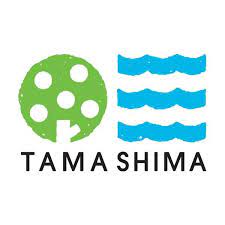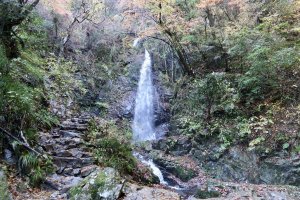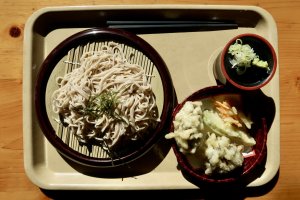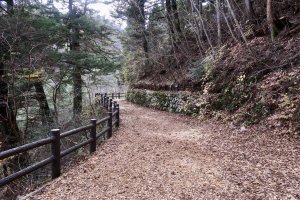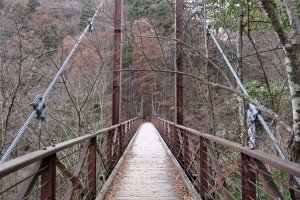Nature has long been interwoven into Japanese culture. Throughout the country, shrines and temples stand in harmony with the environment, and seasonal changes, such as cherry blossoms and autumn leaves, facilitate nationwide celebrations.
Despite Tokyo’s reputation as a concrete jungle, its western area, generally called Tama, is blessed with natural beauty. Here, city-weary Tokyoites can easily escape to the trees to feel refreshed and energized by nature. Located on the western outskirts of Tokyo’s city center, the Tama area is home to a number of onsen (hot springs), ryokan (traditional inns), museums, traditional workshops, outdoor activities, and eateries serving local cuisine.
Take a break from the hustle and bustle of the city, and join us on an adventure through western Tokyo’s relaxed urban environment and natural wonders.
Day One – Nishi Tama
We started our trip in Nishi Tama, or West Tama. Among the Tama area, this predominantly nature-filled region is located the furthest from central Tokyo and encompasses part of the Chichibu-Tama-Kai National Park. From Akishima Station—a roughly 40-minute train ride from Shinjuku Station—we rented a car and then started our journey to the woods.
Route
| Hossawa Falls | |
| → | Tochinomi |
| → | Hinohara Tokyo Citizens' Forest |
| → | Kinkokaku |
Hossawa Falls

Hossawa Falls, located in Hinohara Village, is recognized as one of Japan’s 100 best waterfalls and features four levels of running water that cascade into a clear basin. From the nearby parking lot, which has a bathroom, the waterfall is an easily navigable 15-minute hike.
As I followed the tree-lined path to the falls, I was instantly swept into nature’s embrace where the melody of rustling leaves and the scent of autumn air accompanied my every step. Once I reached the falls, I was greeted by a mesmerizing display of nature. Unrestricted trees and plant life decorated the rocky cliffside and wove a dense wall of nature around the falls. I climbed the short stone staircase beside the 60-meter waterfall for a closer look and watched the water pour into the rippling basin. As a cool mist settled on my cheeks, I was immediately touched by nature's rejuvenating qualities.
Tochinomi for Lunch

After experiencing the healing powers of nature, it was time to nourish ourselves with some local cuisine at Tochinomi! Located about a 40-45 minute drive from Hossawa Falls and based in the Forest Hall at Hinohara Tokyo Citizens' Forest, Tochinomi is a small eatery most popular for its tendon, or assorted tempura (airy, deep fried vegetables, meat, or seafood) over rice. The restaurant also sells numerous other dishes, including soba (buckwheat noodles) and udon (thick wheat noodles), that range from 650 to 1,200 yen. As an extension of the encircling naturescape, the bright dining space is decorated with wooden furniture and has floor-to-ceiling windows for plenty of natural light.

I ordered soba with a side of local vegetable tempura. Without a doubt, the star of the meal was the maitake, which is a local mushroom and specialty of Hinohara. The hearty mushroom was plump and juicy and paired wonderfully with the crunchy tempura coating.
Hinohara Tokyo Citizens' Forest (Hinohara Tomin no Mori)

With full stomachs, we started our exploration of Hinohara Tokyo Citizens' Forest. This forested park is home to numerous hiking trails—varying from 0.9 to 7.6 kilometers—and includes natural sights, such as Mito Otaki Falls, Mt. Osawayama, Mt. Mito, and Mt. Toishiyama. The trails feature wooden rest areas, bathrooms, bird-watching huts, and scenic lookout points to ensure that all visitors have a comfortable journey. Aside from hiking opportunities, the Citizens' Forest Park also has multiple facilities with nature displays, a bouldering wall, and wood making workshops!

For our trip, we took the Mito Otaki Falls walking trail, which is approximately 0.9-km long and suitable for all ages thanks to its relatively flat terrain. From the Forest Hall, we started on the Otaki Forest Therapy Path—a part of the Mito Otaki Falls walking trail. This aptly named path is blanketed with hinoki (Japanese cypress) wood chips and provides a scented and cushioned trail through dozens of sugi (Japanese cedar) and evergreen trees.

At the end of the therapy path, we reached the hike’s namesake—the Mito Otaki Falls. From our vantage point on the nearby Takimi bridge, we were gifted with an enchanting view of the waterfall against the tree-clad cliffside.

Afterwards, we returned to the Forest Hall, and visited the nearby wood craft center. Here, I created a dinosaur keychain! The mindful activity of tracing, cutting, and sanding the woodblock was the perfect way to end the forest adventure.
Kinkokaku

As the sun set for the day, we drove about 50-60 minutes to Kinkokaku—our accommodation for the night. This ryokan rests on the banks of the Akigawa River and is renowned for its cultural charm and encircling natural beauty.
After checking in, I picked up a floral yukata, a lighter type of kimono, provided by the ryokan and changed into the attire for dinner. In a room lined with tatami floors, I enjoyed a beautifully-plated spread of grilled ayu (a local fish), steak and mushrooms, seasonal vegetable tempura, seasoned tofu, sashimi, fluffy rice, shrimp gratin, and pineapple for dessert. I paired the meal with a sweet umeshu, or plum liqueur.

During dinner, the accommodation’s staff laid out a futon in my room, which is a quilted mattress traditionally used in Japan for sleeping, as well as sheets, a pillow, and comforter. The room embodied traditional Japan with tatami floors, fusuma (paper-covered sliding doors), and a warm kotatsu (heated table with blanket), and included amenities such as towels, toothbrushes, and toothpaste. Thanks to the nature-filled day, I fell asleep swiftly with a calm headspace.
Day Two – Minami Tama
The next day, we explored Minami Tama, which translates to South Tama. Compared to Nishi Tama, this area is closer to central Tokyo and is home to a unique blend of natural beauty, museums, and urban life.
Route
| Hachioji Castle Ruins | |
| → | Mt. Takao Cable Car |
| → | Takaosan Yakuo-in Temple |
| → | Mt. Takao’s Summit |
Hachioji Castle Ruins

After a filling breakfast at Kinkokaku, we drove about 30 minutes to Hachioji Castle Ruins—one of Japan’s 100 famous castles. This mountaintop castle was likely constructed between 1583 and 1584 and was attacked soon after in 1590. Today, only a few stone foundations remain. However, thanks to the area’s seasonal beauty and historic significance, it serves as a popular hiking spot.

Upon entering the expansive grounds, we followed the forested Old Path to Hikihashi—a wooden bridge built across the Shiroyama River. This bridge led to a massive stone staircase that acted as the entrance to the ruins of the main palace. While once grand, the only remainder of the palace today are stones. As I walked along the nature-reclaimed structure, I wondered who walked these steps before me and imagined what the castle was like in its prime. Past this main area, we ventured into the forest and hiked to Goshuden no taki—the waterfall of the Main Palace. Afterwards, we walked back to the parking lot and enjoyed the calming presence of the trees.
Mt. Takao Cable Car

After exploring the shadows of the past, we continued our outdoor adventure at Mt. Takao—one of Tokyo’s most renowned nature retreats. From the Hachioji Castle Ruins, the drive was about 25 minutes. This lush area is popular in all seasons and home to seven hiking trails—most of which lead to Mt. Takao’s summit. The most frequented trail, called Omotesando Trail or Trail No. 1, is lined with dozens of souvenir shops, eateries, and handheld treats, such as dango (sweet rice flour dumplings) and tenguyaki (crispy pastry with black bean paste). Without a doubt one of the highlights of Mt. Takao is the Cable Car, which brings visitors roughly halfway up the mountain along a tree-lined path. The cable car climbs about 271 meters in six minutes with a maximum incline of 31 degrees, making it one of Japan’s steepest cable car lines! As we ascended the mountainside in the vibrantly painted cable car, I was enamored by the fiery foliage against the cloudless sky.
Takaosan Yakuo-in Temple

After disembarking at Takaosan Station, we followed Trail No. 1 to Yakuo-in Temple near the mountain’s summit. This Buddhist temple was established in 744 and is closely associated with tengu, which are demon-like creatures portrayed with long noses that chastise evildoers and protect the good. Consequently, the temple is a popular spot for visitors to pray to avoid troubles.
From the impressive Shitenno-mon Gate, we first made our way to the Main Hall. This remarkable building was decorated with intricate wood carvings and was bustling with praying visitors purifying themselves with incense. Past this hall, we followed a stone staircase punctuated by a bright torii gate to the Izuna Gongen-do Hall. This vermillion structure featured more wood carvings painted with blues and greens and stood as an enchanting sight among the trees.
Mt. Takao’s Summit

With good fortune from the tengu, we continued our journey to the mountain’s summit. Mt. Takao’s summit is 599 meters tall and is recognized as one of the Kanto region’s 100 famous views of Mt. Fuji. Along with its awe-inspiring panoramas, this topmost point is also home to the Takao Visitor Center, a few restaurants, and bathrooms.
When we first reached the summit, we were treated to expansive vistas of lush mountains against distant views of Tokyo’s skyline—reminding us that we were, in fact, still in Tokyo. After marveling at the contrasting visuals of nature and city life, we walked to the opposite side of the summit to find Mt. Fuji, and thanks to the clear weather, we found it! Amid the staggered silhouettes of mountains, Mt. Fuji’s distant peak rose above all. With the sunlight warming my face, I felt touched by not only Mt. Fuji, but the entire landscape.
Day Three – Kita Tama
After exploring Tama’s west and south regions, we ended our trip in Kita Tama, or North Tama. Located closest to central Tokyo, Kita Tama is more developed than Tama’s other areas and features a balanced environment of parks and city life. From Higashi-Koganei or Musashi-Koganei Station, which are about 30-minute train rides from Shinjuku Station, we took a bus to our first stop (about 12-13 minutes).
Route
| Edo-Tokyo Open Air Architectural Museum | |
| → | Jindaiji Temple |
| → | Yuusui |
| → | Inokashira Park |
| → | Harmonica Yokocho Alley |
Edo-Tokyo Open Air Architectural Museum

We started our final day by traveling to the past at Edo-Tokyo Open Air Architectural Museum, located in Koganei Park. In 1993, the Tokyo Metropolitan Government established the 7-hectare museum to relocate, reconstruct, preserve, and exhibit historical buildings. The buildings are grouped into three zones—west, center, and east—and exhibit people’s lifestyles from the 17th to 20th century.

Similar to our journey through Tama, we started in the museum’s west zone and then worked our way east. Our first stop was an Edo period (1603-1867) farmhouse that exemplified traditional Japanese architecture with its thatched roof and wooden construction. Next, we moved to the 1900s and admired homes that uniquely blended western and Japanese style designs. I enjoyed walking through the structures and imagining how the original owners spent their time. Lastly, we visited Shitamachi-naka Street—a downtown area lined with shops, a bar, a workshop, an inn, and a bath house dating back to the mid-1800s to mid-1900s. Although the buildings were constructed long before my time, I still felt a sense of nostalgia for the past eras.
Jindaiji Temple

Then, for easy travel, we decided to take a cab and drove about 30 minutes to our next destination—Jindaiji Temple. This temple was first established about 1,300 years ago and is recognized as one of Tokyo’s oldest Buddhist temples. Thanks to the area’s abundance of natural spring water, Jindaiji is also famous for its quality soba, or buckwheat noodles, and features a number of restaurants within walking distance of its main gate.

Upon entering the grounds through the San-mon (Main gate), we were first greeted by the massive Hon-do (Main hall). With a simple color palette of dark wood and white, the commanding structure wonderfully complemented the surrounding foliage. After wafting in the healing aromas of incense, we moved to the Ganzan-daishi-do, another remarkable hall that enshrines a rarely seen statue of Ganzandaishi, a famous monk from the Heian period. Then, we walked along the water-lined street just outside the main gate and admired the collection of quaint shops and soba restaurants.
Lunch at Yuusui

Naturally, after enjoying the temple grounds, we had to try some of the area’s renowned soba! We decided to visit Yuusui, which is located on Jindaiji Street and about a two-minute walk from the temple. This restaurant makes its own soba with domestic milled buckwheat flour and incorporates seasonal and local vegetables into its menu.
The staff seated us at a traditional Japanese table with tatami floors where we removed our shoes and knelt. The restaurant kindly provided us with an English menu, which included a variety of hot and cold soba dishes, and provided helpful information about ingredients, such as nuts, meat, and dairy products, for food allergies and preferences. I ordered soba with vegetable tempura. The chewy, yet earthy aroma of the noodles complemented the soy sauce-based dipping sauce perfectly. As customary, I finished the meal with a hot cup of sobayu, which is the water leftover from cooking soba noodles.
Inokashira Park

Following lunch, we took a cab again to Inokashira Park, which took about 25 minutes. Established about 100 years ago, the park serves as a natural oasis surrounded by urban life and is home to nature trails, the Ghibli Museum, a pond, a shrine, and even a zoo! While the park’s scenery shines in all seasons, it is especially popular during spring and autumn with its pastel cherry blossoms and vibrant autumn foliage.

Upon entering the park, we first headed to the Benten bridge. Here, we were treated to a pleasant view of Benzaiten Shrine reflected in the slow moving waters. Next, after a quick stop by the shrine, we walked to the Nanai bridge and watched couples happily paddle swan boats across the water—one of the park’s most renowned activities. Then, with no destination in mind, we simply wandered through the trees. Despite its close proximity to urban development, the park served as a wonderful place to connect with nature.
Harmonica Yokocho Alley

For our last destination, we decided to explore the area’s nightlife at Harmonica Yokocho Alley, located about a 10-minute walk from Inokashira Park. This atmospheric alleyway is situated in the chic neighborhood of Kichijoji, which is popular for its fashion, shopping, and gourmet culture. The alley itself is filled with quirky character and has a retro atmosphere reminiscent of its past as a flea market after WWII. The street’s small eateries and izakaya (Japanese style bars) serve pizza, gyoza, and more!

With the glow of red lantern light and the enticing smells of savory dishes filling the night, we entered a restaurant that specialized in yakitori, or skewered meat. Upon ordering, the staff quickly grilled a variety of chicken and beef skewers, which we paired with crisp beer. The freshly prepared meat coupled with the cool beer and alluring atmosphere of the alleyway made for a fun way to end our journey in Tama.
Tama’s Natural and Cultural Charm
While nature is often not the first quality people associate with Tokyo, the Tama region is home to a plethora of natural beauty, spirituality, and slow urban life. In this region, mountains, waterfalls, parks, temples, shrines, and museums sit in perfect harmony and offer a wealth of opportunities for exploration. Next time you visit Tokyo, venture off the beaten path, spend some time among Tama’s trees, and experience the healing qualities of nature for yourself.
Access to Tama
Thanks to its close proximity to central Tokyo, Tama, in general, is easily accessible via public transportation. From Tokyo Station, you can take a variety of train lines to reach your desired destination, and once you arrive in Tama, you can use buses, taxis, or rental cars to explore the area.
